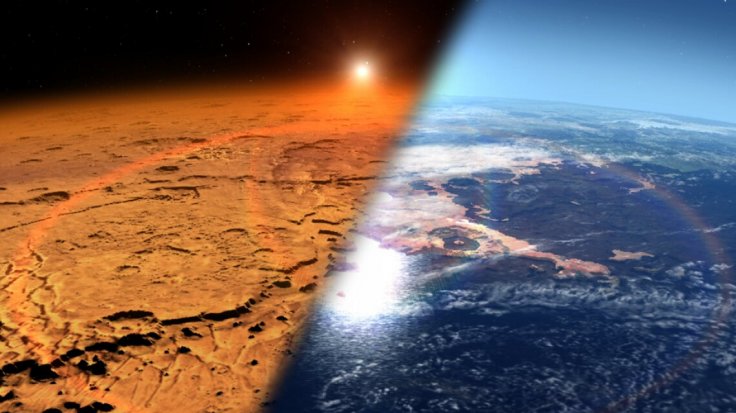Scientists have long believed that Mars' surface once was similar to Earth with oceans and rivers flowing on the Red Planet billions of years ago. Fossilized river and ocean beds are evidence of that. Mars is now bone dry and the only water exists is as ice at the north and south poles. However, scientists have now revealed the mystery of Mars losing its water.
Researchers previously assumed that water vapor could not escape to space as the heavy molecules could not have traveled high enough through Mars' thin atmosphere. It had to fall back on the surface. But NASA's Mars Atmosphere and Volatile Evolution (MAVEN) orbiter has a different story to tell. Scientists have observed a large number of water molecules in Mars' upper atmosphere, from where the water is lost into space.
The water much like Earth goes through a cyclical process. Due to the planet's thin atmosphere, the Sun's ultra-violet rays evaporate the water molecules. But thanks to Martian dust storms, it pushes the molecules to the upper atmosphere, accelerating the process. Shane Stone, a graduate student at the University of Arizona Lunar and Planetary Laboratory, has been working on the MAVEN mission and detailed his findings in a study that was published in the journal Science on Thursday, November 12.

MAVEN's Findings
MAVEN travels through Mars' atmosphere once every four and a half hours. Its Neutral Gas and Ion Mass Spectrometer (NGIMS) instruments onboard measure the planet's charged water molecules in the upper atmosphere, 100 miles from the surface. That way, scientists can determine the amount of water present in the planet's atmosphere.
Through MAVEN and Hubble Space Telescope, researchers observed that Mars had an oval orbit around the Sun compared to Earth. It comes closest to the Sun during the summer of its southern hemisphere every two Earth years. The warming of the planet melts the ice found on the surface and sends it to the upper atmosphere from where it is lost into space. In the cyclical movement, UV rays break the ice melts and the water molecules into hydrogen and oxygen. But the process is slow and would take years to complete. That however contradicts the current observations.
"This is important because we didn't expect to see any water in the upper atmosphere of Mars at all. If we compare Mars to Earth, water on Earth is confined close to the surface because of something called the hygropause. It's just a layer in the atmosphere that's cold enough to condense and therefore stop any water vapor traveling upward," Stone said.

Dust Storms
The team observed something weird — a florescent fog of hydrogen in Mars' upper atmosphere. That could have been only possible due to the presence of water. The fog slowly faded as the summer approached. The one most important factor in this is Mars' dust storms — regional and global. The regional storm occurs every Martian year and the global storm ravages the planet every 10 years. The charged dust particles further heat up the planet and fuel the water molecules' upward movement.
During the storms, scientists observed spikes of water in Mars' upper atmosphere. Before the beginning of the 2018 storms, scientists observed that the presence of water in the upper atmosphere more than doubled to over six million parts of water per million. But during the storms, the level rose to 60 parts per million. The studies showed that Mars had lost about 17 inches of global ocean water due to the cyclical movements while additional 6.7 inches of water due to the dust storms.









